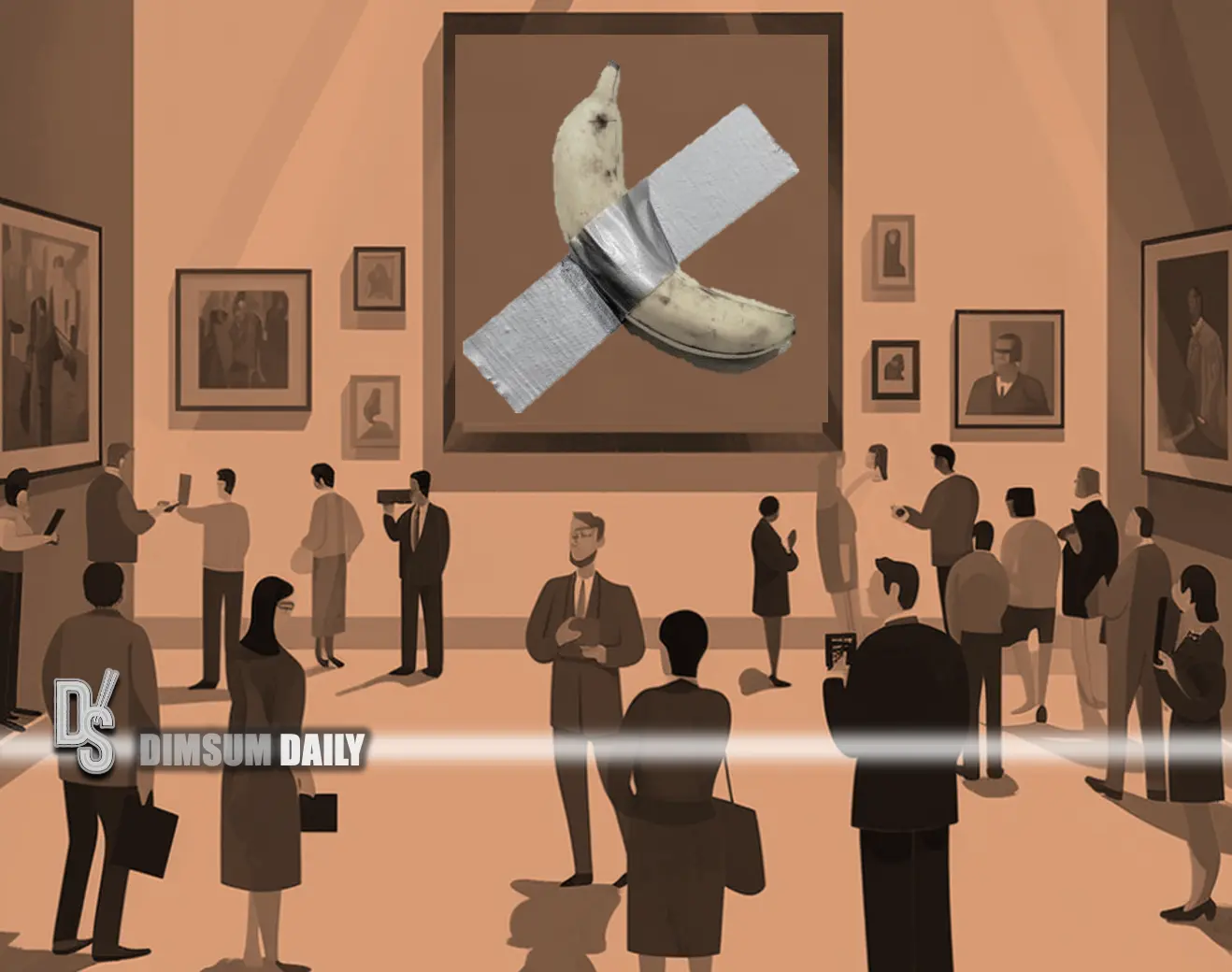
5th November 2024 – (New York) In what might be the ultimate validation of its satirical premise, Maurizio Cattelan’s notorious “Comedian” – better known as the banana duct-taped to a wall – will head to Sotheby’s auction block on 20th November with an estimated value of $1 million to $1.5 million. The sale of one of three editions of this controversial work, which originally sold for $120,000 at Art Basel Miami Beach in 2019, represents a staggering appreciation that seems to perfectly fulfil the artwork’s sardonic commentary on art market inflation. The winning bidder will receive a certificate of authenticity, a roll of duct tape, and detailed instructions for properly displaying a fresh banana – essentially paying seven figures for the right to periodically tape fruit to a wall.
The spectacle of a banana duct-taped to a wall commanding such astronomical sums perfectly encapsulates the theatrical absurdity of today’s art market. For Cattelan, the self-taught Italian artist known for his satirical approach and prankster reputation, the Sotheby’s auction represents both a triumph of his artistic vision and a darkly comic fulfilment of his critique. While the original $120,000 price tag generated global headlines and debates about the value of conceptual art, the current seven-figure estimate suggests the art market has not only absorbed the criticism but transformed it into an even more valuable commodity.
The work’s brilliance lies in its simplicity – a common banana affixed to a wall with grey duct tape. The genius is not in the physical execution, which anyone could replicate, but in how it forces us to confront the increasingly absurd valuations in the contemporary art market. When the work sold for $120,000 at Art Basel Miami Beach in 2019, it sparked both outrage and bemusement, exactly as Cattelan intended.
The earlier incident at Seoul’s Leeum Museum of Art, where a hungry student casually consumed the banana before taping its peel back to the wall, adds another layer of conceptual complexity. The student’s action, whether intentional performance art or simple hunger, highlights the work’s inherent tension between object and idea. The museum’s matter-of-fact replacement of the banana highlights that the physical fruit is merely a prop in a larger conceptual framework.
The true brilliance of Cattelan’s “Comedian” lies not in its physical manifestation but in how it functions as a mirror, reflecting the art market’s own absurdities back upon itself. When Sotheby’s announces plans to auction one edition for an estimated $1-1.5 million, complete with a certificate of authenticity and installation instructions, we witness the very system Cattelan critiques eagerly participating in its own parody.
The work operates on multiple levels of irony. First, there’s the obvious absurdity of paying six figures for something that costs less than a dollar at any grocery store. Then there’s the deeper irony of the art market’s attempts to commodify and add value to this critique of commodification itself. The fact that buyers receive a certificate of authenticity and detailed instructions for banana replacement only heightens the work’s satirical punch – bureaucratising the simple act of taping produce to a wall.
Cattelan’s background as a self-taught artist who emerged from designing furniture in Forlì, Italy, informs his outsider’s perspective on the art world’s pretensions. His entire career, from convincing gallerist Emmanuel Perrotin to wear a giant phallic rabbit costume to installing a golden toilet in the Guggenheim, has been marked by a willingness to expose the emperor’s new clothes of contemporary art. “Comedian” represents the culmination of this career-long critique.
The work’s viral moments – from performance artist David Datuna eating the banana at Art Basel to the recent hungry student in Seoul – demonstrate how Cattelan’s provocation continues to generate exactly the kind of spectacle that drives art market valuations. Each incident of banana consumption becomes another chapter in the artwork’s mythology, paradoxically increasing its market value while reinforcing its critique of that very market.
When the Perrotin gallery insists that buyers are purchasing the concept rather than the physical banana, they unknowingly highlight the absurdity of the entire enterprise. The idea that someone would pay $120,000 for the right to tape fresh bananas to a wall according to precise specifications perfectly encapsulates the art market’s transformation of conceptual gestures into luxury commodities.
The work’s title, “Comedian,” suggests Cattelan sees himself as a sort of tragic clown, forced to participate in the very system he critiques. Like a court jester speaking truth to power through jokes, he delivers his criticism of art market excess through acts of apparent artistic excess. The banana becomes both prop and punchline in this elaborate performance.
The artwork’s journey from Art Basel sensation to Sotheby’s auction lot represents a kind of circular completion of Cattelan’s critique. The very institutions and market mechanisms he satirises have embraced and monetised that satire, creating exactly the kind of absurd valuation the work was meant to ridicule. It’s a perfect demonstration of the art market’s ability to commodify even its own criticism.
For serious collectors and institutions, “Comedian” presents an uncomfortable paradox. To acquire the work is to participate in the very system it critiques, yet to dismiss it as mere provocation is to miss its incisive commentary on contemporary art valuation. This tension perfectly embodies the contradictions of today’s art market, where even the most anti-commercial gestures can become luxury commodities.
As “Comedian” continues its journey through prestigious institutions and auction houses, its meaning evolves while its critique remains potent. Each new banana taped to each new wall serves as a reminder of how far the contemporary art market has strayed from the radical gestures of Duchamp’s ready-mades, which questioned the nature of art itself rather than generating million-dollar sales.
Perhaps the ultimate irony is that by creating such an effective critique of art market excess, Cattelan has produced exactly the kind of valuable commodity the market craves – a work that generates endless discussion, controversy, and cultural capital. The banana may rot, but the concept appreciates, demonstrating both the genius of Cattelan’s critique and the market’s insatiable ability to profit from its own criticism.
This post was originally published on this site be sure to check out more of their content






